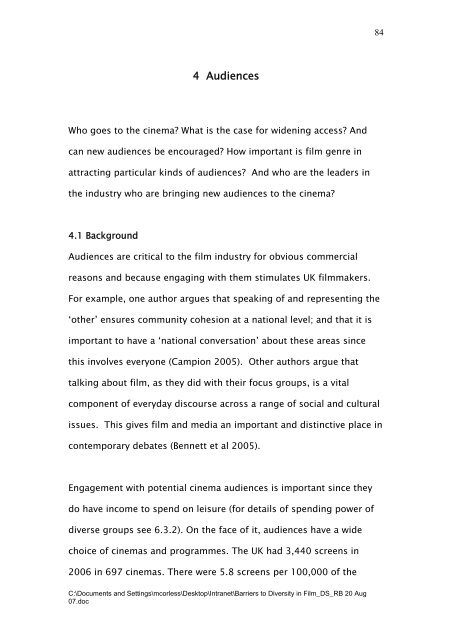Barriers to Diversity in Film – A Research Review – Aug 07
Barriers to Diversity in Film – A Research Review – Aug 07
Barriers to Diversity in Film – A Research Review – Aug 07
You also want an ePaper? Increase the reach of your titles
YUMPU automatically turns print PDFs into web optimized ePapers that Google loves.
4 Audiences<br />
Who goes <strong>to</strong> the c<strong>in</strong>ema? What is the case for widen<strong>in</strong>g access? And<br />
can new audiences be encouraged? How important is film genre <strong>in</strong><br />
attract<strong>in</strong>g particular k<strong>in</strong>ds of audiences? And who are the leaders <strong>in</strong><br />
the <strong>in</strong>dustry who are br<strong>in</strong>g<strong>in</strong>g new audiences <strong>to</strong> the c<strong>in</strong>ema?<br />
4.1 Background<br />
Audiences are critical <strong>to</strong> the film <strong>in</strong>dustry for obvious commercial<br />
reasons and because engag<strong>in</strong>g with them stimulates UK filmmakers.<br />
For example, one author argues that speak<strong>in</strong>g of and represent<strong>in</strong>g the<br />
‘other’ ensures community cohesion at a national level; and that it is<br />
important <strong>to</strong> have a ‘national conversation’ about these areas s<strong>in</strong>ce<br />
this <strong>in</strong>volves everyone (Campion 2005). Other authors argue that<br />
talk<strong>in</strong>g about film, as they did with their focus groups, is a vital<br />
component of everyday discourse across a range of social and cultural<br />
issues. This gives film and media an important and dist<strong>in</strong>ctive place <strong>in</strong><br />
contemporary debates (Bennett et al 2005).<br />
Engagement with potential c<strong>in</strong>ema audiences is important s<strong>in</strong>ce they<br />
do have <strong>in</strong>come <strong>to</strong> spend on leisure (for details of spend<strong>in</strong>g power of<br />
diverse groups see 6.3.2). On the face of it, audiences have a wide<br />
choice of c<strong>in</strong>emas and programmes. The UK had 3,440 screens <strong>in</strong><br />
2006 <strong>in</strong> 697 c<strong>in</strong>emas. There were 5.8 screens per 100,000 of the<br />
C:\Documents and Sett<strong>in</strong>gs\mcorless\Desk<strong>to</strong>p\Intranet\<strong>Barriers</strong> <strong>to</strong> <strong>Diversity</strong> <strong>in</strong> <strong>Film</strong>_DS_RB 20 <strong>Aug</strong><br />
<strong>07</strong>.doc<br />
84
















